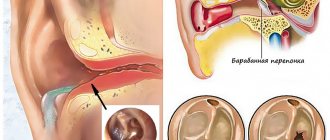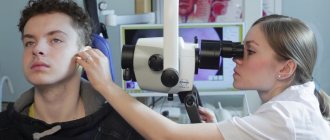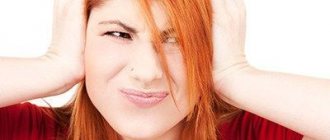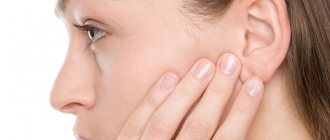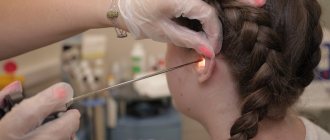ENT clinic No. 1 provides treatment for exudative otitis media
Author:
- Yanova Natalya Yurievna
otorhinolaryngologist of the highest qualification category
3.60 (Votes: 5)
Exudative or serous otitis is an inflammation of the mucous membrane of the middle ear, with accumulation of fluid in the tympanic cavity, hearing loss, often in the absence of pain, and a whole eardrum.
The disease occurs more often in preschool children, less often in schoolchildren and adults.
Middle ear device
Otitis media of the middle ear
Immediately behind the eardrum is the tympanic cavity, which contains three small auditory ossicles - the malleus, the incus and the stapes. With the help of a system of these bones, sound vibrations are removed from the eardrum and transmitted to the inner ear. The tympanic cavity is connected to the nasopharynx by the auditory (or Eustachian) tube. This connection with the nasopharynx makes the ear sensitive to diseases of the nose and throat.
What is needed for diagnosis?
To diagnose this disease, it is necessary to conduct a complete otorhinolaryngological examination. The most informative examination today is using video endoscopic equipment. During the examination, the doctor can observe the fluid level and air bubbles behind an unchanged or thickened, clouded eardrum. If necessary, to confirm the diagnosis, tympanometry is recommended, after which the otolaryngologist will be able to draw a complete picture of the condition of the tympanic cavity and middle ear as a whole.
During a traditional examination, the pathology may remain undetected and be diagnosed already at the stage of complications and hearing loss by an audiologist.
Causes of otitis media
Otitis media can develop as a complication of otitis externa, but more often the infection enters the middle ear from the nasopharynx through the Eustachian tube. In this case, otitis media is a complication of colds. It is enough to blow your nose incorrectly when you have a runny nose (without pinching one nostril), and discharge from the nose with a current of air can enter through the auditory tube into the tympanic cavity. Normally, the middle ear is sterile, so the penetration of bacteria from the nasopharynx can easily lead to the development of inflammation. If this happens against the background of a weakened immune system, the development of otitis media is very likely. acute otitis media usually occurs
which in a significant number of cases quickly turns into a purulent form.
The development of inflammation can be facilitated by the accumulation of fluid (exudate) in the middle ear. This fluid is constantly produced. Normally, it should leave the middle ear through the auditory (Eustachian) tube. This evacuation can be difficult due to diseases and pathologies of the nose (rhinitis, adenoids, deviated nasal septum), as well as diseases of the auditory tube itself (eustachitis, tubootitis). In this case, the fluid fills the space of the middle ear, becomes viscous, and interferes with the functioning of the auditory ossicles. This condition is defined as exudative otitis media.
.
Infection of the accumulated fluid leads to the transition of exudative otitis media to chronic purulent otitis media
.
Treatment of exudative (serous) otitis.
After diagnosis using a video endoscope, the patient’s management tactics become obvious. To treat serous otitis, anti-inflammatory therapy is necessary, aimed at clearing the middle ear cavity from exudate through natural pathways, i.e., through the auditory tube. To do this, it is necessary to relieve inflammatory swelling in the nasopharynx, and as a result in the auditory tube. The end of inflammation leads to recovery with complete restoration of hearing.
Our clinic has extensive experience in anti-inflammatory treatment of edematous mucous membranes of the nasopharynx and auditory tubes. In addition to drug therapy, a wide range of effective physiotherapeutic procedures are used for treatment, which will significantly speed up the healing process and, in most cases, do without surgery.
- ultrasound therapy with the USOL device (has an anti-edematous and anti-inflammatory effect on the nasal cavity, nasopharynx and auditory tube anastomosis),
- laser therapy (anti-inflammatory, antibacterial effect),
- electrophoresis on the area of the temporal bone (allows to improve blood circulation in the sore ear, has an anti-inflammatory, absorbable effect),
- blowing of the auditory tubes and pneumomassage of the eardrum (allows mechanical opening of the auditory tubes to evacuate secretions, making the membrane more elastic and pliable, restoring ventilation of the middle ear),
- in more complex cases, with a persistent, long-term process, catheterization of the auditory tubes is used, which makes it possible to deliver medications directly into the anastomosis of the auditory tube, which will have a more pronounced anti-inflammatory and decongestant effect and thereby speed up the healing process.
Otitis media in children
Otitis in children
Otitis media is a common childhood disease. Children suffer from otitis media more often than adults, this is caused by a number of reasons:
- The Eustachian tube in children is shorter and wider than in adults, and is located more horizontally. All this facilitates the entry of mucus from the nasopharynx into the middle ear;
- children suffer from colds more often;
- children often cry and sniffle at the same time, as a result of which nasal secretions can get into the auditory tube;
- Children often have adenoids - a pathologically enlarged pharyngeal tonsil that blocks the Eustachian tube. Difficult ventilation of the tympanic cavity contributes to the development of infection.
Breasts are even more vulnerable. In newborns, there is a special (myxoid) connective tissue in the middle ear, loose, gelatinous, with a small number of blood vessels, which is a very favorable environment for the development of harmful bacteria. Breasts spend most of their time lying down, which interferes with the outflow of mucus. When regurgitated, milk can enter the auditory tube and tympanic cavity.
Otitis media in young children appears suddenly. The temperature rises to 39-40° C. The baby begins to cry in pain; He can't sleep and refuses to suckle. He constantly touches the sore ear - but this is only from the age of four months, and before that it is possible to establish what exactly the child is hurting in only by indirect signs. The picture is also complicated by possible gastrointestinal manifestations of otitis media – diarrhea and vomiting.
Therefore, it is very important to show the child to the doctor. If your child has a high temperature, call a doctor at home. If a child complains of ear pain, it is necessary to take him to an ENT doctor.
ENT CENTER
Exudative otitis is an inflammation of the lining of the middle ear. Most common in young children. It is non-infectious in nature and there is no pain. But the consequences can be very serious - partial hearing loss.
Exudative otitis media should be distinguished from the more well-known acute otitis media, which is a consequence of infection and causes severe pain.
Serous exudate, a sticky fluid, accumulates in the middle ear. Over time it becomes thicker. The disease is not accompanied by pain or damage to the eardrum. This makes diagnosing the disease difficult. What makes you see a doctor is hearing loss, which is also gradual.
Under normal conditions, the fluid that is produced in the middle ear spontaneously comes out through the Eustachian (auditory) tube. This tube connects the tympanic cavity to the nasopharynx. Its function is that air enters the ear cavity through it, and wax and mucus come out. The production of mucus is protective in nature against the penetration of bacteria, but, having completed its task, it must leave the ear cavity, making room for a fresh portion.
If the patency is impaired, exudate accumulates in the ear cavity and inflammation begins. The fluid thickens and then turns into pus.
When the passage narrows, not enough air enters the tympanic cavity. Due to the created vacuum, the eardrum begins to swell and retract. This has a negative impact on hearing.
The most common causes of this disease:
- diseases of the nasopharynx - rhinitis, sinusitis, pharyngitis, tonsillitis, sinusitis;
- adenoids;
- allergic reactions;
- deviated septum - congenital or after injury;
- reduced immunity.
The cause may also be physical pressure when water enters the ear cavity.
The classification of this disease involves division into types, forms and stages.
There are two types depending on the location of the inflammation:
- unilateral when only one ear is affected - left-sided exudative otitis media or right-sided exudative otitis media, respectively;
- bilateral – for inflammation in both ears.
According to statistics, unilateral exudative otitis media is less common and occurs in 10% of cases with this disease.
There are the following forms of exudative otitis media:
- acute;
- subacute;
- chronic.
The acute form is the initial one. Its symptoms are not pronounced, and the duration is no more than three weeks. The subacute or secretory form is characterized by an increase in the viscosity of the exudate accumulated in the ear space. Lasts up to two months. In the absence of treatment, after eight weeks from the onset of the disease, the chronic form begins.
If the disease lasts more than eight weeks, a diagnosis of chronic exudative otitis media is made. Hearing loss may become irreversible.
The development of the disease goes through four stages:
- The first one is initial. Inflammation occurs and ventilation in the auditory tube decreases. There are no symptoms, there is a slight deterioration in hearing and resonance of one’s own voice inside the head. The duration of the stage is about one month.
- The second is secretory. Mucus has accumulated in sufficient quantities. The hearing deteriorates even more and there is congestion in the ears and a feeling of fluid transfusion in the head. Duration – from month to year.
- The third is mucosal. The contents of the ear cavity become more viscous, and hearing loss intensifies. The feeling of transfusion inside the ear goes away. The stage lasts one to two years.
- The fourth is fibrous. Mucus is produced less and less, and then stops completely. The tympanic cavity is destroyed and persistent hearing loss occurs.
The disease is easiest to treat in the first stage. But due to the mild severity of symptoms, it is difficult to diagnose.
Bilateral exudative otitis media is difficult to diagnose, especially at an early stage. If this disease is unilateral, a clue may be the difference in the right and left ear. If you observe a child who does not yet know how to speak, you will notice that he tries to lie on the side with the sore ear in order to reduce the discomfort.
The main symptoms include:
- nasal congestion;
- a feeling when you tilt your head, as if liquid is pouring inside;
- booming audibility of one's own voice inside the head;
- difficulty breathing through the nose;
- impaired perception of sounds;
- hearing loss.
At the initial stage, a slight increase in temperature is possible.
Exudative otitis, the symptoms and treatment of which depend on the form and stage, having reached a chronic state, can cause more serious complaints of the patient. Severe hearing loss occurs, which is no longer possible not to pay attention to. You can already hear your voice inside more strongly, as if the person is under water. There is no pain as before.
Making a diagnosis begins with interviewing the patient. After listening to his complaints and learning about recent illnesses, the doctor will begin an examination. The first assistant to the otolaryngologist is the otoscope. With its help, the condition of the eardrum is assessed.
Other diagnostic methods are:
- Endoscopy. Detects narrowing of the auditory tube.
- The Valsalva maneuver and the use of a Siegle funnel are used to check the degree of decrease in the mobility of the tympanic membrane.
- Tympanometry is carried out to assess the mobility of the eardrum using a probe installed in the ear canal. The generator makes sounds, the pump changes the pressure. Signals reflected from the eardrum are recorded.
- Blowing of the auditory tubes according to Politzer in order to find out the degree of their patency. It is both a diagnostic and therapeutic method.
- Audiometry. Determines hearing acuity quite accurately.
- A tuning fork test tests sensitivity to sounds of different frequencies.
- Radiography.
- Computed tomography – to clarify the diagnosis.
- Diagnostic tympanocentesis. A thin puncture of the eardrum is made and a small amount of contents is taken through the hole for analysis.
Diagnostic methods are prescribed by an otolaryngologist.
At the onset of middle ear disease, a diagnosis is made of acute otitis media. Exudative otitis media in its initial form is the easiest to treat. Regardless of the form, treatment must be comprehensive.
Anti-inflammatory therapy should definitely be carried out. For sinusitis, vasoconstrictor drugs are prescribed. Sinusitis is dealt with by washing or puncture. In severe cases, antibiotics are prescribed.
If allergic edema is present, antihistamines are prescribed. Mucolic drugs will help thin the thickened exudate. Taking multivitamins and immunomodulators is used as maintenance therapy. To restore normal breathing through the nose, polyps and adenoids are removed.
Your doctor will tell you how to treat exudative otitis media if drug treatment does not help. If the threat of hearing loss continues, the following physiotherapeutic procedures may be prescribed:
- Blowing of the Eustachian tube according to Politzer. The air flow increases the lumen, the mucus comes out.
- It is possible to use a catheter through which a solution is infused to relieve swelling. It will take several procedures to wash away dried pieces of exudate.
- Electrophoresis. An electrode with medication applied to it is inserted into the ear canal. Under the influence of current, it penetrates deep into the skin.
- Pneumomassage. The eardrum is exposed to it.
- Laser irradiation. Inflammation and swelling are relieved.
- Magnetotherapy.
- Ultrasound.
Bilateral acute exudative otitis media requires procedures for each ear separately. The patient's age is taken into account, since not all of these methods are suitable for young children. If conservative treatment is not successful, surgical intervention will have to be used. When diagnosed with exudative otitis media, treatment is carried out both on an outpatient basis and in an inpatient setting.
Indications for surgical intervention are the absence of the expected result from the use of conservative therapy.
- During a myringotomy, a hole is made in the eardrum. The accumulated exudate comes out.
- A fairly effective procedure is shunting of the tympanic cavity for exudative otitis media. The operation is safe and can be used on adults and children. Shunt surgery, also called tympanostomy, involves inserting a shunt, which is a small tube, into a small incision. Due to this, the ventilation function is restored. Anti-inflammatory drugs are administered through the shunt. The shunt can remain in the ear for a long time.
- A simple operation is paracentesis. A needle makes punctures through which mucus comes out.
Any operation for exudative otitis lasts a short time. After the operation, a follow-up examination with a doctor is required ten days later.
In addition to the medications and procedures recommended by your doctor, you can use traditional medicine recipes.
- It is recommended to make decoctions and infusions from yarrow, plantain, lavender, and eucalyptus. The moistened swab is inserted into the ear canal for 20 minutes.
- In the acute stage, heated oil is instilled, which is purchased at the pharmacy.
- A proven remedy is onions. Boil the squeezed juice and, after cooling, drop it into your ear.
The products used should be warm, but we should not forget that in no case should you heat the sore ear with the pus accumulated in it.
Preventive measures include:
- increasing immunity;
- hardening;
- sanitation of the nasal cavity;
- timely treatment of ARVI;
- maintaining hygiene;
- avoiding hypothermia;
- Regular visits to an otolaryngologist if you have a history of the disease.
After physiotherapy, it is not recommended to walk for some time. In chronic cases, cover the ear canals with cotton swabs before washing your hair. When walking, wear a hat that covers your ears.
Parents should be attentive to changes in their children's behavior. Delayed treatment can lead to complications.
Symptoms of otitis media
Acute otitis media is usually manifested by the following symptoms:
Earache
Ear pain with otitis media can be pulsating, “shooting,” or vice versa. nagging, incessant pain can radiate (give) to the temple and back of the head, and teeth may begin to ache.
Hearing impairment
Hearing deterioration in otitis media is typical for the initial period of the disease, but can be observed throughout the entire course of the disease. The ear, as they say, “blocks up.” The patient may hear extraneous noises or his own voice as if from within (autophony effect).
Temperature
Body temperature can rise to 39° C.
More about the symptom
Ear discharge
Serous or purulent discharge from the diseased ear may be observed.
General weakness
The disease is characterized by general malaise; Nausea and sometimes vomiting are possible.
Symptoms of exudative otitis media
It is important to consider that exudative otitis media is accompanied by painful sensations, usually only in complicated cases.
Typically, patients with exudative otitis media complain of decreased hearing and a feeling of fullness in both ears or one ear.
Hearing impairment with the development of exudative otitis is fluctuating, since the patency of the resulting mucus plug can decrease and increase.
In addition, the disease can go away naturally, but then the threat of its recurrence remains.
Treatment methods for otitis media
Treatment of otitis media
Severe, “shooting” pain in the ear, characteristic of acute otitis media, leaves no other option but to immediately begin treatment of the disease. However, it is highly desirable that treatment of otitis occurs under the guidance of a physician.
Left without proper treatment, otitis media can become chronic. In this case, the pain in the ear ceases to be painful. For a long time, the patient may not feel pain at all. This is explained by the fact that in chronic otitis media the eardrum remains perforated, and through this hole pus can flow into the ear canal without creating excess pressure in the eardrum. A constant focus of inflammation and impaired integrity of the eardrum contribute to the development of hearing loss.
Another danger: improper treatment can lead to the formation of adhesions and scars in the tympanic cavity, disrupting the functioning of the auditory ossicles and blocking the auditory canal. This is the so-called adhesive otitis media , which leads to persistent hearing loss and the appearance of tinnitus.
Other complications are also possible. A timely visit to a doctor will help avoid complications and maintain hearing acuity. The usual course of treatment for otitis lasts ten days.
Specialist consultation
If two days have passed and your ear is still bothering you, you should definitely see an ENT specialist. There is a possibility that the disease may progress to the next stage, in which purulent discharge begins to accumulate in the middle ear. Accumulated pus can rupture the eardrum. It is advisable to avoid this. If, nevertheless, pus needs to be removed from the tympanic cavity, then it is better for a doctor to do this by making a careful puncture of the eardrum, the so-called paracentesis.
Make an appointment Do not self-medicate. Contact our specialists who will correctly diagnose and prescribe treatment.
Rate how useful the material was
thank you for rating
Forms
Doctors divide exudative otitis media by whether it affects one or two ears, and by the duration of the course. The first classification distinguishes unilateral (left-sided or right-sided) otitis and bilateral. The second divides the disease into the following categories:
- acute exudative otitis - the acute form includes a disease that is completely cured within a period of up to three weeks;
- subacute exudative otitis - its duration is more than three weeks, but not more than 8 weeks;
- chronic exudative otitis media - the disease of this form lasts more than 8 weeks. Its treatment is more complex and lengthy than acute and subacute forms. It also significantly increases the likelihood of complications.
Not only the doctor, but also the patient himself can determine which otitis media occurs in a particular case, if he remembers exactly when the first signs of pathology appeared. In some cases, symptoms of exudative otitis media may be absent, and then it is discovered by chance during a routine medical examination or when contacting a specialist for another reason. As a rule, this happens if the disease is chronic.
Carrying out treatment
It is much easier to cure acute otitis media if treatment for the disease begins as early as possible. Treatment should be carried out under the supervision of an otolaryngologist. Complex treatment includes the following activities:
- for acute pain, taking analgesics is indicated to relieve pain;
- to bring down the temperature you need to take antipyretic drugs;
- in difficult cases, antibiotic treatment is carried out;
- local treatment consists of using special ear drops, which are prescribed individually in each case. Self-selection of drops, as well as antibacterial drugs, is fraught with dangerous consequences for health.
- Antihistamines help relieve swelling;
- a good effect is achieved during physiotherapeutic procedures;
- surgical intervention: opening of the eardrum (paracentesis) is carried out if spontaneous rupture has not occurred.
All ENT doctor’s prescriptions must be followed in full: after all, following treatment recommendations is the key to a quick recovery.
Clinical picture
In acute catarrhal otitis, painful sensations of an aching, shooting nature occur in the affected ear, hearing impairment, congestion, and noise are noted.
With catarrhal otitis of infectious origin, all of the above symptoms may be accompanied by an increase in body temperature.
An otorhinolaryngologist, upon examination, notes redness of the eardrum and its retraction. There may be severe pain when pressing on the tragus.
In the absence of appropriate therapy, catarrhal otitis media can develop into exudative and purulent perforated otitis media. Therefore, it is necessary, if the above symptoms occur, to promptly seek help from an otolaryngologist.
What not to do during treatment
Some patients are overly self-confident and believe that a disease such as otitis media can be easily cured with the help of folk remedies and “grandmother’s” recipes. A wide variety of methods are used. This is a huge misconception!
The first mistake is that no foreign objects should be placed in the ear canal. Some are trying to use phytocandles, others, for example, geranium leaves. Such measures are fraught with the fact that leftover leaves may get stuck in the ear, which will provoke increased inflammation.
The second mistake is the use of heat and warming compresses for the purulent form of the disease. Some people replace compresses with a heating pad. At this stage of the disease, thermal heating will only increase the proliferation of bacteria.
The third mistake is trying to instill various oils or variations of alcohol into the ears. If during such treatment a perforation of the eardrum occurs, such instillations will not only cause pain, but will also cause scarring in the middle ear and eardrum.
Outer and inner ear: causes of inflammation
Otitis externa can develop due to improper ear hygiene. If you don't take care of your ears, dirt will accumulate in them, and this is a favorable environment for the growth of bacteria. Excessive hygiene is also harmful: earwax is a natural barrier against the penetration of bacteria into the ear. If you diligently clean the ear canals every day, a person loses this barrier and opens the way for pathogens. Another mistake that leads to acute ear inflammation is cleaning the ears with sharp objects that are not intended for this (toothpicks, matches, hairpins). Such actions can lead to damage to the auricle, which in turn leads to infection entering the wounds. Another factor is dirty water that gets into the ear, which contains pathogens. “Swimmer’s ear” is another name for this type of disease.
As we have already said, inflammation of the internal region occurs due to undertreated otitis media, if due attention has not been paid to the treatment of otitis media. Bacteria can also get here from the meninges, for example, with meningitis. This type of inflammation can be caused by injuries and fractures of the skull or temporal bone.
In order to recognize the disease in time and choose the right treatment, you need to be able to identify its signs.
Complications and preventive measures
As a rule, if you start treating the disease on time, treatment of acute purulent otitis, exudative or inflammation of any other kind, you can avoid any complications.
However, if treatment is not carried out and the disease progresses, the diagnosis can become chronic. The most serious consequences are: meningitis, encephalitis, brain abscess, facial neuritis, hearing loss. But these dangerous conditions can only appear when patients persistently neglect treatment for otitis media.
Preventive measures include the fight against existing foci of inflammation in the body, competent and timely treatment of ENT diseases, proper ear hygiene and, of course, strengthening the immune system.
Types of disease
Inflammation that occurs in the organ of hearing can be chronic or acute. In acute cases of otitis, the disease lasts for up to three weeks, in chronic cases - more than three months. The chronic process starts when treatment of the acute form of otitis was not carried out or was not carried out at the proper level. There is also an intermediate form - subacute, when the duration of the disease ranges from three weeks to three months.
The human hearing organ is divided into three parts: the outer, middle and inner ear. Otitis may appear in each of these areas. Based on the location of the inflammation, acute otitis media is distinguished, and inflammation of the inner ear, otherwise known as labyrinthitis.
External manifestations of inflammation, in turn, are divided into limited, manifesting mainly in the form of a boil of the auricle, and diffuse otitis media. With diffuse otitis, a significant area of the outer ear is affected.
Acute inflammation of the middle ear involves the tympanic cavity of the ear, the auditory (Eustachian) tube and the mastoid process. This type of hearing disease is the most common.
Make an appointment right now!
Call us by phone or use the feedback form
Sign up
The disease of the internal part is called labyrinthitis (this part of the ear is called the labyrinth because of the similarity of its shape to the cochlea). As a rule, inflammation covers the internal part if the treatment of inflammatory disease of the middle ear was carried out late or the treatment for otitis media was chosen incorrectly.
Based on the causes of occurrence, infectious otitis media is distinguished, caused by various pathogens, and non-infectious (for example, arising due to exposure to allergens or ear injuries).
Otitis in acute form can occur in catarrhal (without the formation of secretion in the ear cavity), exudative (with the formation of fluid in the tympanic cavity) and purulent (with the presence of purulent masses) forms.
